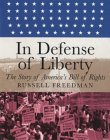|

Freedman, Russell. 2003. In defense of liberty: The story of
America's Bill of Rights. New York: Holiday
House. ISBN: 0823415856.
By beginning with a brief story that outlines what could happen to a
citizen if there were no Bill of Rights, Freedman subtly makes his case
for why knowing about the Bill of Rights should be important to every
American. After a brief history of how the Bill of Rights came to
be written, the following chapters detail each of the first Ten
Amendments. Brief summaries of the Thirteenth, Fourteenth, and
Fifteenth Amendments are also included. The conclusion contains a
picture of the original handwritten Bill of Rights along with notes, an
index of Supreme Court cases, a selected bibliography, and an index.
"Careful scholarship" (Litherland 2004) noted by a reviewer is evident
in the many details of the text. For each Amendment, Freedman
gives history that explains why the forefathers included the Right, and
then cites real world examples of how it is applied in our
society. Historical court cases along with modern challenges or
invocations of each Right not only allow the reader to see how the
Amendment has applied in the past but also its applications
today. For example, in explaining the Sixth and Seventh
Amendments, which give the right to a fair trial (pp.115-128), Freedman
is able to show the evolution of this Amendment across time through
real-world examples. From challenges to the Amendment that
changed trial juries from being comprised of white males to people of
both genders and all races to defendants who spoke up and demanded that
they be given a court appointed lawyer, Freedman translates the
high-brow language of America's founders into readable stories that put
civil rights in context. Black and white reproductions of
historical artwork and contemporary pictures further illustrate how the
Bill of Rights has been applied in our society.
When the topic is something as hotly debated as the Bill of Rights,
questions arise about the author's objectivity. Although he is able to
give real world examples that show the different facets of each
Amendment, Freedman himself admits that his own biases bleed into his
writing. In an interview for Book Links magazine, Freedman said,
"I do have values and opinions and they may inevitably have an effect
on my approach to a book and my attitude toward the subject, but I make
a conscious effort to include both sides. I don't think it's
possible to be completely objective. I think this comes out in
how certain things are emphasized. For example, in the chapter
about gun control, I tried to give both sides, but I don't think it's
neutral. Why would I spend all that time writing this book if I
didn't have an opinion about the value of the Bill of Rights?" (Giorgis
and Johnson 2004)
Giorgis, Cyndi, and Nancy J. Johnson. 2004. Talking with
Russell Freedman. Book
Links 13(4): 43-45. In EBSCOHost (database
online). Available from http://search.epnet.com/login.asp.
Accessed 2 June 04.
Litherland, Tena Natale. 2004. In defense of liberty:
The story of America's Bill of Rights (book review). Library Media Connection
22(6): 79. In EBSCOHost (database online). Available
from http://search.epnet.com/login.asp. Accessed 14 June 04.
|

